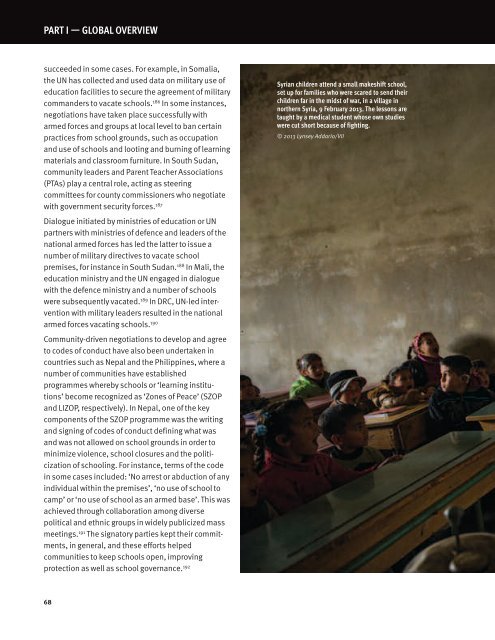Create successful ePaper yourself
Turn your PDF publications into a flip-book with our unique Google optimized e-Paper software.
PART I — GLOBAL OveRvIeW<br />
succeeded in some cases. For example, in Somalia,<br />
the UN has collected and used data on military use of<br />
education facilities to secure the agreement of military<br />
commanders to vacate schools. 186 In some instances,<br />
negotiations have taken place successfully with<br />
armed forces and groups at local level to ban certain<br />
practices from school grounds, such as occupation<br />
and use of schools and looting and burning of learning<br />
materials and classroom furniture. In South Sudan,<br />
community leaders and Parent Teacher Associations<br />
(PTAs) play a central role, acting as steering<br />
committees for county commissioners who negotiate<br />
with government security forces. 187<br />
Dialogue initiated by ministries of education or UN<br />
partners with ministries of defence and leaders of the<br />
national armed forces has led the latter to issue a<br />
number of military directives to vacate school<br />
premises, for instance in South Sudan. 188 In Mali, the<br />
education ministry and the UN engaged in dialogue<br />
with the defence ministry and a number of schools<br />
were subsequently vacated. 189 In DRC, UN-led intervention<br />
with military leaders resulted in the national<br />
armed forces vacating schools. 190<br />
Community-driven negotiations to develop and agree<br />
to codes of conduct have also been undertaken in<br />
countries such as Nepal and the Philippines, where a<br />
number of communities have established<br />
programmes whereby schools or ‘learning institutions’<br />
become recognized as ‘Zones of Peace’ (SZOP<br />
and LIZOP, respectively). In Nepal, one of the key<br />
components of the SZOP programme was the writing<br />
and signing of codes of conduct defining what was<br />
and was not allowed on school grounds in order to<br />
minimize violence, school closures and the politicization<br />
of schooling. For instance, terms of the code<br />
in some cases included: ‘No arrest or abduction of any<br />
individual within the premises’, ‘no use of school to<br />
camp’ or ‘no use of school as an armed base’. This was<br />
achieved through collaboration among diverse<br />
political and ethnic groups in widely publicized mass<br />
meetings. 191 The signatory parties kept their commitments,<br />
in general, and these efforts helped<br />
communities to keep schools open, improving<br />
protection as well as school governance. 192<br />
Syrian children attend a small makeshift school,<br />
set up for families who were scared to send their<br />
children far in the midst of war, in a village in<br />
northern Syria, 9 February 2013. The lessons are<br />
taught by a medical student whose own studies<br />
were cut short because of fighting.<br />
© 2013 Lynsey Addario/VII<br />
68


